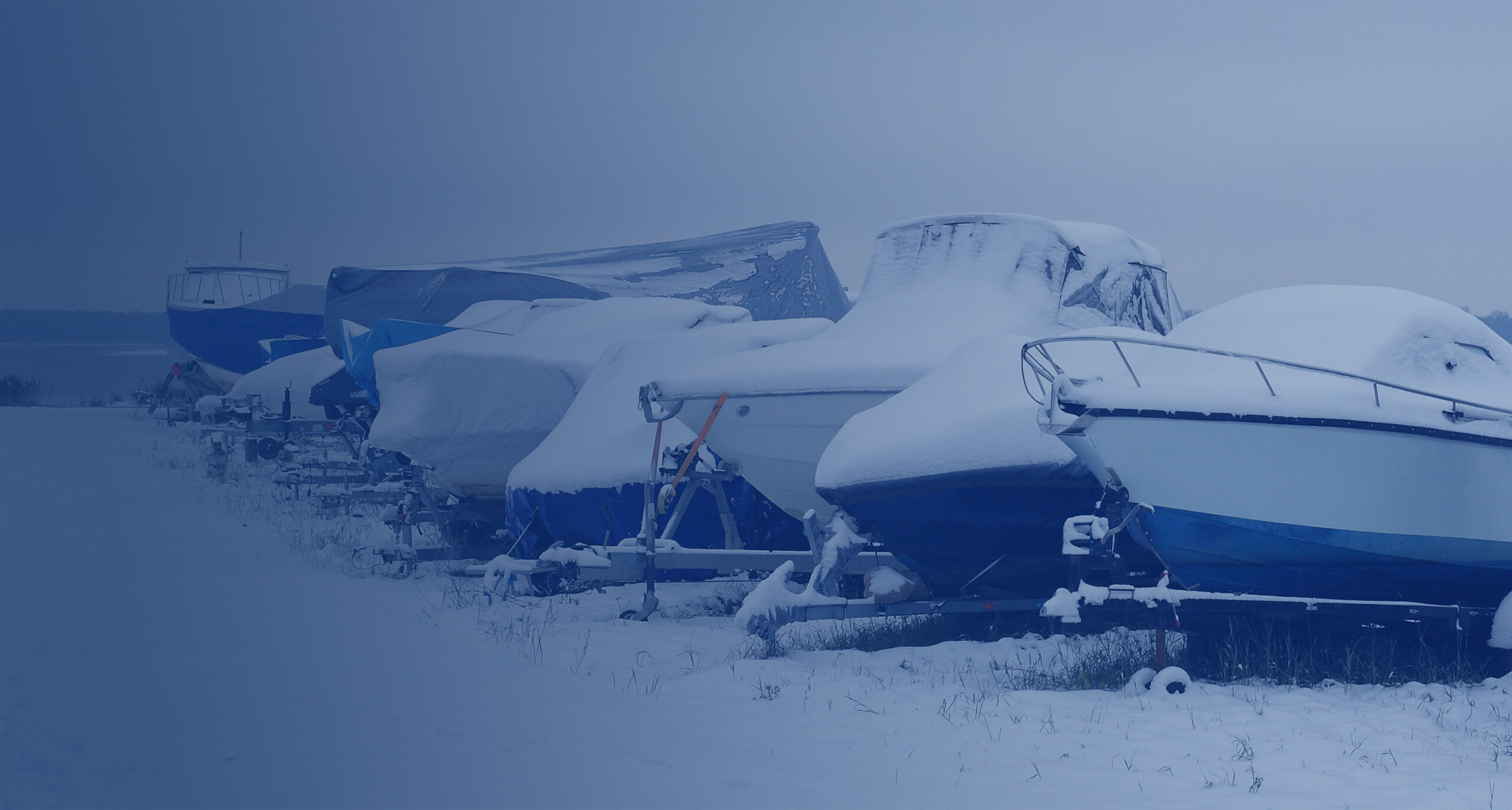Caring and Maintaining a boat through the winter is a great opportunity to hit the reset and take care of necessary boat projects that may be neglected during the peak of the boating season. Projects like a ripped cushion or hazed or cracked hatch lexan, do not stop your boat from running, but fixing them in the off-season brightens your boat’s presentation when you are aboard. Whether you are a fair weather boater or an all-season boater, winter boat maintenance is an important part of caring for your vessel. Following this two part guide to winter boat maintenance can ensure that as the weather warms and the days lengthen - your boat will be refreshed from the last days of the season and in ship-shape condition ready to begin a new one.
Part 1: Clean the Boat
Every boat benefits from a more thorough cleaning here and there. If you are putting the boat away for the winter this cleaning is best done before the boat is put into storage. If the boat stays in use through the winter, be sure to take an opportunity sometime this fall to give the boat a solid winter once over.
- Clean Topsides and topside holds:
- Use fresh water to rinse down topsides.
- Use Soapy water and a microfiber cloth or sponge to eliminate mildew and/or loosen debris. A brush can be used on non-skid. Pay close attention to corners.
- Fresh water rinse again.
- Wash, wax, and buff fiberglass hull and glossy top side areas
- Wash the boat with biodegradable soap. There are many choices from boat wash specific soaps to Dawn. Regardless of the product, always remember a little goes a long way.
- Rinse with freshwater and wipe down with dry microfiber cloth to ward against water spots.
- Wax and Buff. Find rhythm in the simple movement, give up some elbow grease, wax and buff the hull and glossy topsides from stem to stern. Product choice is important here. You get what you pay for.
- Clean and Polish Stainless:
- Use Fresh water to rinse down all the stainless.
- Wipe down stainless with microfiber cloth and a stainless cleaner. If there is wood, varnish or brightwork in the vicinity of the stainless, pay close attention to keep the cleaner from sitting on the brightwork.
- Fresh water rinse again.
- Dry with dry microfiber cloth.
- Maintain Fishing Equipment if applicable:
- Fresh water rinse all equipment.
- Loosen moving parts like outriggers, downriggers, and any equipment that has movable parts that can have salt water corrosion in them. Rinse, dry, lubricate, and retighten.
- Scrub clean cutting stations and coolers with a mild bleach solution to eliminate any organic or inorganic matter.
- Clean live wells by circulating a solution of water, vinegar and hydrogen peroxide through the system. Follow with fresh water. Dry completely.
- Clean and Dry Canvas, cushions, and life jackets:
- Soak or spot clean with a canvas specific soap or a light Simple Green solution.
- Let dry completely.
- If the boat is being taken out of the water for the season, it is worth considering stowing everything not integral to the boat off the boat or down below. Store the boat inside or beneath a well fitting boat cover.
- Empty and Clean Refrigerator/Freezer and or food storage areas
- Winter is a good time to clear out all food items and give spaces a wet wipe down. Remove any food ‘stuff’ on the sides, top and bottom of food spaces with a mild cleanser.
- If the boat will remain in use, replace food items. If the boat is being winterized, store all unopened, non-perishable food items in lock-tight containers or better still off the boat.
*Maintenance Tip: While giving your boat this extra attentive cleaning take the opportunity to notice any damage that could be taken care of over the winter instead of during the warmer generally more active boating season. For example, if a cushion is torn mend it or take it to an upholsterer. If a hinge is loose, tighten it and check others. Left unattended a torn cushion will tear more, and loose hinges can bend or break off their frame. Mending and fine tuning these details at the early signs of damage in the off season keep boat owners connected with their boat. This will also lessen the scope of perpetual wear and tear, while increasing one’s joy when boating more actively come spring or summer.
Part 2: Regular, Annual, or Hours of Use Winter Care and Maintenance
A boat owner is wise to use the winter to tackle annual boat maintenance and further familiarize themselves with the proper function of all their boat’s parts and systems. Boats have many parts, and systems that need annual or hours of use inspection, lubrication, replacement, updates, and/or adjustments. Taking the winter months to move through the boat’s parts and systems that need annual attention will keep you on the water time smoothly and ideally trouble-free.
Always refer to the boat's part or system specific owners manual for guidelines or hire a professional for any or all areas outside your ‘wheelhouse’. Whether or not the following inspections are done by the boat owner or a professional, the more familiar a boat owner is with the proper functioning of various parts and systems aboard, the more easily one will recognize any departure from what is normal proper function.
- Engine
- Flush the engine with freshwater if it has not been flushed already. This will remove any impurities from the system.
- Check and top up coolant.
- Change the Oil and filters on 4-stroke outboards and inboard engines.
- Change lower unit oil on outboards. Inspect seals and o-rings at this time. Change as needed to maintain watertight seal.
- Replace water impeller on outboard engine/s.
- Heat exchangers can come off inboard engines. Clean and pressure test them for leaks. Address any issues and reinstall.
- Check Belts for proper tension on inboard engines.
- Clean and check spark plug gaps. Replace as needed.
- Check and clean sea strainers.
- Examine engine block/ head. Wipe down any dirt or gummy debris on the engine/s. Spray with an anti-corrosive.
- Lubricate moving parts.
- Electronics and electrical
- Check electronics for updates
- Check wiring connections for integrity and corrosion.
- Connections may need tightening. Others may require wiping, scrubbing with a wire brush, spraying with a corrosion inhibitor, or replacement.
- Check wiring connections that may be in the bilge. Check for integrity and consider relocating.
- If possible take electronics off the boat and bring them home.
- Running Gear (propellor/s, prop shaft, cutlass bearings, struts, rudder)
- Inspect all running gear for damage. Damage can be as subtle as a hairline crack near the base and the hull connection, or more easily observed in the form of a bend, dent, or ding in the prop or strut. Repair as needed.
- Check the play of the bearings, renew as needed. A new cutlass is needed when the gap exceeds the proper clearance tolerance for the shaft. Tolerance is based on shaft size. Refer to the shaft owners manual for specifics.
- Inspect and change zincs as needed.
- Fuel System
- Change fuel filter on motor/s.
- Depending on the motor type and size, one should address the fuel tanks. Small outboards should be run out of fuel. Larger fuel tanks should be filled and fuel stabilizer added. Close fuel vent. The key is to eliminate the possibility of condensation introducing water into your fuel system.
- Inspect Fuel lines and connections. All should be secure and in good condition. Tighten and/or change as necessary.
- Trailer
- Inspect wheels (tread and pressure), bearings, winch cable, and tie downs. Tires should be in good condition and pressure filled according to manufacturers specifications. Bearings and winch should always be well greased. Repack bearings every 3-5 seasons.
- Inspect wiring for secure connections and lights for proper function.
- Bilges
- Inspect bilge pumps for blockage and proper function.
- Inspect bilge spaces. Are they wet? Is there water or oil in the bilges or on the bilge diaper/s?
- If not, congratulations!
- If there is, wipe and dry bilge with a sponge. If there was oil, remove and replace the bilge diaper. Trace liquid to source. Eliminate leak or water infiltration.
- Water System
- Check all hoses in your water system. Make sure connections are tight and there are no leaks.
- Holding Tank
- Empty Holding tank either a minimum of 3 miles offshore or at a pump out station. Pump additional water through the toilet and out of the tank each pump out to keep sludge from settling to a solid buildup in the holding tank. If you suspect a buildup in your tank there are many holding tank specific treatment products that are effective and eco-friendly. These products add microbacteria that feed on the solids and liquify them so that tanks can get fully emptied at the pump out.
- Sea cocks
- Exercise sea cocks by opening and closing them. Lubricate sea cocks as needed with silicon grease so that the action is smooth. Leave in a closed position except for cockpit and deck drains.
- Safety Gear
- Every boat should be outfitted with a well stocked first aid kit that is sized to the number of crew aboard and the average trip length/distance away from definitive care. Take time in the winter months to check in with the boat’s first aid kit. Restock depleted items and/or out of date medications. Captain and crew specific medications should be added and updated as needed.
- Check fire extinguishers, flares, EPIRBS. Keep registered and up to date.
- If the boat is equipped with smoke detectors and/or carbon monoxide alarms - check them. Replace batteries as needed.
While safety gear is the last item in this guide to winter boat maintenance, it is certainly not the least. In fact, all of this winter work directly improves your safety aboard. With your improved knowledge and understanding, routine care and maintenance, you can feel confident that you, your crew, and your boat will be safer on the water.
While doing your best for your boat will improve your confidence in your boat, it does not protect you or your boat from every hazard on and off the water. Ahoy! Can help you face even the unpredictable with confidence. Get a Quote today!


